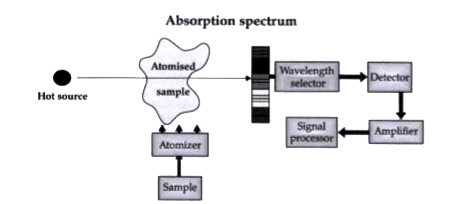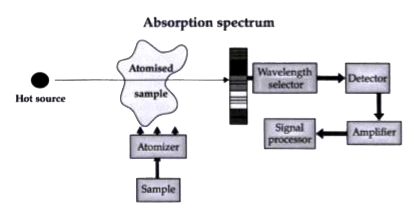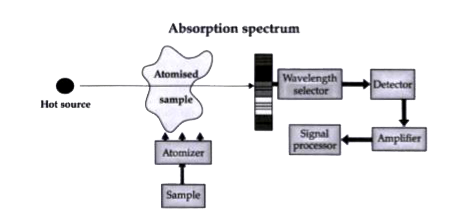Units of parts per million (ppm) or per billion (ppb) are often used to describe the concentrations of solutes in very dilute solutions. The units are defined as the number of grams of solution per million or per billion gram of solvent. Bay of Bengal has 2.1 ppm of lithium ions. What is the molality of Li+ in this water ? (Li = 7)
The correct Answer is:3.0×10−4
Step by step video, text & image solution for Units of parts per million (ppm) or per billion (ppb) are often used to describe the concentrations of solutes in very dilute solutions. The units are defined as the number of grams of solution per million or per billion gram of solvent. Bay of Bengal has 2.1 ppm of lithium ions. What is the molality of Li^(+) in this water ? (Li = 7) by Chemistry experts to help you in doubts & scoring excellent marks in Class 12 exams.
Topper's Solved these Questions
- BOOK - ALLENCHAPTER - CONCENTRATION TERMSEXERCISE - Exercise S - II10videos
CONCENTRATION TERMS
- BOOK - ALLENCHAPTER - CONCENTRATION TERMSEXERCISE - Exercise O-I33videos
CONCENTRATION TERMS
- BOOK - ALLENCHAPTER - CONCENTRATION TERMSEXERCISE - Basic Exercise14videos
CONCENTRATION TERMS
- BOOK - ALLENCHAPTER - ACIDIC STRENGTH & BASIC STRENGTHEXERCISE - Exercise V16videos
ACIDIC STRENGTH & BASIC STRENGTH
Similar Questions
100 mL of 0.6 M acetic acid is shaken with 2 g activatid carbon . The final concetration solution after adsorption is 0.5 M. what is the amount of acetifc acid adsorbed per gram of carbon ?
View SolutionConverting molality to molarity: Ethylene glycol, C2H4(OH)2 is a colourless liquid used as an automobile antifreeze. If the density at 20∘C of a 4.500m solution of ethylene glycon in water is 1.279gmL−1, what is the molarity of the solution? The molar mass of ethylene giycon is 62.00gmol−1.
Strategy: A 4.500m solution of ethylene glycol water contains 4.500mol of glycol in every one kilogram of water. To find the solution's molarity, we must find the number of moles of solute per litre of solution. We can find volume fome the mass the mass of the solution by using density as a conversion factor.
So we cam take the mass of solution that contains 1kg of H2O and use the density to convert this quantity of solution to volume.View Solution
Knowledge Check
- Question 1 - Select One
A: 1 gram of salt in 1m3 of solution has concentration of 1 ppm.
R: ppm is defined as number of parts by mass of solute per million parts of solution.AIf both Assertion & Reason are true and the reason is the correct explanation of the assertionBIf both Assertion & Reason are true but the reason is not the correct explanation of the assertionCIf Assertion is true statement but Reason is falseDIf both Assertion and Reason are false statements - Question 2 - Select One
Assertion: The concentration of pollutants in water or atmosphere is often expressed in terms of ppm
Reason :Concentration in parts per million can be expressed as mass to mass, volume of volume and mass to volume .AIf both assertion and reason are true and reason is the correct explanation of assertionBIf both assertion and reason are true but reason is not the correct explanation of assertion.CIf assertion is true but reason is falseDIf both assertion and reason are false - Question 3 - Select One
Read the following text and answer the following questions on the basis of the same:
Atomic Absorption Spectrometer: The atomic absorption (AA) spectrometer is used to analyze metals at very low concentrations, typically in the parts per million (ppm) or parts per billion (ppb) ranges. A liquid sample containing dissolved material whose concentration is to be measured is aspirated into a thin, wide AA flame, or is introduced into a small carbon furnace which is heated to a high temperature.

Basic Principle of AAS is the measurement of absorption of radiation by free atoms. The total amount of absorption depends on the number of free atoms present and the degreee to which the free atoms absorb the radiation. At the high temperature of the AA flame, the sample is broken down into atoms using an atomizer and it is the concentration of these atoms that is measured. Sample in the form of solution is used. It is broken up into a fine mist with the help of an atomizer. When the mist reaches the flame, the intense heat breaks up the sample into its individual atoms. When a photon coming out from the hot source hits an atom and the energy of the photon is equal to the gap between two electron energy levels of the atom, then the electron in the lower energy level absorb the photon and jumps up to the higher energy level. If the photon energy does not correspond to the difference between two energy levels, then the photon will not be absorbed (it may be scattered away). Hence in the spectrum, the wavelength corresponding to the absorbed photons is observed as black lines as shown in the following spectrum of Hydrogen. The dark lines correspon to the frequencies of light those have been absorbed by the sample element. Using this process, a source of photons (generally a white light) of various energies is used to obtain the absorption spectra of different materials and to identify them.
What should be the concentration of metal for analysis using Atomic Absorption Spectrometer?AVery High concentrationBVery low concentrationCMedium concentrationDAny concentration
Read the following text and answer the following questions on the basis of the same:
Atomic Absorption Spectrometer: The atomic absorption (AA) spectrometer is used to analyze metals at very low concentrations, typically in the parts per million (ppm) or parts per billion (ppb) ranges. A liquid sample containing dissolved material whose concentration is to be measured is aspirated into a thin, wide AA flame, or is introduced into a small carbon furnace which is heated to a high temperature.

Basic Principle of AAS is the measurement of absorption of radiation by free atoms. The total amount of absorption depends on the number of free atoms present and the degreee to which the free atoms absorb the radiation. At the high temperature of the AA flame, the sample is broken down into atoms using an atomizer and it is the concentration of these atoms that is measured. Sample in the form of solution is used. It is broken up into a fine mist with the help of an atomizer. When the mist reaches the flame, the intense heat breaks up the sample into its individual atoms. When a photon coming out from the hot source hits an atom and the energy of the photon is equal to the gap between two electron energy levels of the atom, then the electron in the lower energy level absorb the photon and jumps up to the higher energy level. If the photon energy does not correspond to the difference between two energy levels, then the photon will not be absorbed (it may be scattered away). Hence in the spectrum, the wavelength corresponding to the absorbed photons is observed as black lines as shown in the following spectrum of Hydrogen. The dark lines correspon to the frequencies of light those have been absorbed by the sample element. Using this process, a source of photons (generally a white light) of various energies is used to obtain the absorption spectra of different materials and to identify them.
What happens when a photon hits an atom and the energy of the photon is not equal to the gap between two electron energy levels of the atom?View SolutionRead the following text and answer the following questions on the basis of the same:
Atomic Absorption Spectrometer: The atomic absorption (AA) spectrometer is used to analyze metals at very low concentrations, typically in the parts per million (ppm) or parts per billion (ppb) ranges. A liquid sample containing dissolved material whose concentration is to be measured is aspirated into a thin, wide AA flame, or is introduced into a small carbon furnace which is heated to a high temperature.

Basic Principle of AAS is the measurement of absorption of radiation by free atoms. The total amount of absorption depends on the number of free atoms present and the degreee to which the free atoms absorb the radiation. At the high temperature of the AA flame, the sample is broken down into atoms using an atomizer and it is the concentration of these atoms that is measured. Sample in the form of solution is used. It is broken up into a fine mist with the help of an atomizer. When the mist reaches the flame, the intense heat breaks up the sample into its individual atoms. When a photon coming out from the hot source hits an atom and the energy of the photon is equal to the gap between two electron energy levels of the atom, then the electron in the lower energy level absorb the photon and jumps up to the higher energy level. If the photon energy does not correspond to the difference between two energy levels, then the photon will not be absorbed (it may be scattered away). Hence in the spectrum, the wavelength corresponding to the absorbed photons is observed as black lines as shown in the following spectrum of Hydrogen. The dark lines correspon to the frequencies of light those have been absorbed by the sample element. Using this process, a source of photons (generally a white light) of various energies is used to obtain the absorption spectra of different materials and to identify them.
What is the basic principle of Atomic Absorption Spectrophotometer?View SolutionRead the following text and answer the following questions on the basis of the same:
Atomic Absorption Spectrometer: The atomic absorption (AA) spectrometer is used to analyze metals at very low concentrations, typically in the parts per million (ppm) or parts per billion (ppb) ranges. A liquid sample containing dissolved material whose concentration is to be measured is aspirated into a thin, wide AA flame, or is introduced into a small carbon furnace which is heated to a high temperature.

Basic Principle of AAS is the measurement of absorption of radiation by free atoms. The total amount of absorption depends on the number of free atoms present and the degreee to which the free atoms absorb the radiation. At the high temperature of the AA flame, the sample is broken down into atoms using an atomizer and it is the concentration of these atoms that is measured. Sample in the form of solution is used. It is broken up into a fine mist with the help of an atomizer. When the mist reaches the flame, the intense heat breaks up the sample into its individual atoms. When a photon coming out from the hot source hits an atom and the energy of the photon is equal to the gap between two electron energy levels of the atom, then the electron in the lower energy level absorb the photon and jumps up to the higher energy level. If the photon energy does not correspond to the difference between two energy levels, then the photon will not be absorbed (it may be scattered away). Hence in the spectrum, the wavelength corresponding to the absorbed photons is observed as black lines as shown in the following spectrum of Hydrogen. The dark lines correspon to the frequencies of light those have been absorbed by the sample element. Using this process, a source of photons (generally a white light) of various energies is used to obtain the absorption spectra of different materials and to identify them.
How the sample for analysis is deriven to atomic state in AAS?View SolutionStatement-1: Molar conductance of any electrolyte increases with dilution.
Statement-2: With dilution number of ions per mL of the solution decreases.View Solution50 ml of 1 M oxalic acid is shaken with 0.5 g wood charcoal. The final concentration of the solution after adsorption is 0.5 M. What is the amount of oxalic acid adsorbed per gram of carbon?
View Solution

